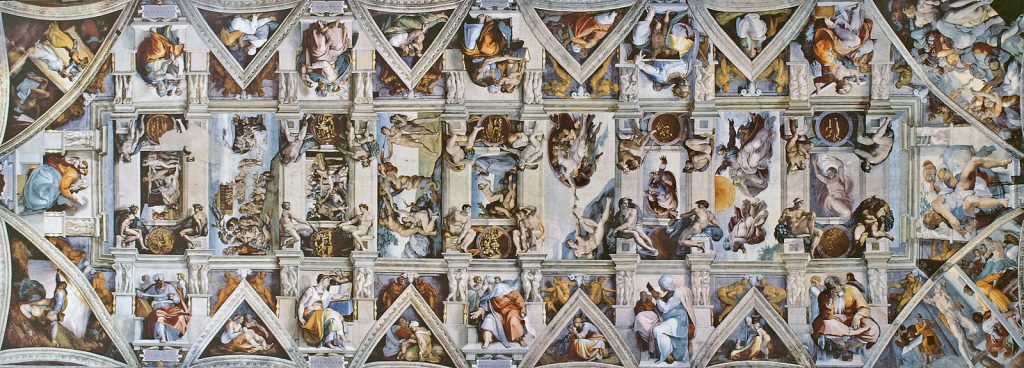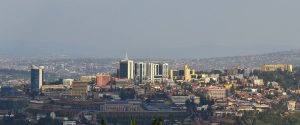From 1508 to 1512, it took Michelangelo five long, torturous years to complete the rigorous task of painting the ceiling of the Sistine Chapel. Spanning more than 10,000 square feet, the iconic piece of high Renaissance art is familiar to many people. Nevertheless, despite Michelangelo’s distinct ability to imply powerful expression and emotion into his art, most people fail to interpret the full story behind the talented artist’s five-year journey. Many may not realize that the beautiful, intricate depictions attributed to Michelangelo were actually painted by an unskilled artist. Likewise, one would not even dare think that the hand behind the brush had minimal interest in painting such marvelous masterpieces.
Michelangelo was by no means recognized as a skilled painter in his time. His fame, rather, came from the sculptures he chiseled in Rome and in Florence in his earlier years. His first sculpture in Rome was Bacchus (1496-1497), which he sculpted for a French ambassador’s barber. The French ambassador then commissioned Angelo to sculpt the Pietà (1498-1499). It was to be Michelangelo’s first contribution to the Catholic Church. The sculpture depicted the Virgin Mary holding the dead body of Jesus Christ. It was widely admired for the pure and simple expression of Mary and the holy serenity of Jesus even in the stillness of death. A few projects later, Angelo worked in Florence, sculpting the massive statue of the biblical hero David. The sculpture David (1501-1504) left Florentine citizens and artists, such as Leonardo Da Vinci, in awe. Eventually, he was assigned to work with Da Vinci painting war cartoons on the walls of the great municipal hall of Florence, known as the Palazzo Vecchio. After treating Da Vinci with severe discourtesy, he was summoned to Rome, by Pope Julius II for a new commission in 1505.1

Upon arriving in Rome, Michelangelo was employed to work on a mausoleum, or sepulcher, for the pope. Julius desired a tomb spanning eight hundred square feet, three stories high, and adorned with twenty six statues. He was willing to pay Michelangelo more than two hundred thousand crowns to complete the grand project. However, the pope’s desires were too extravagant and the expense was absurdly high, so the St. Peter’s basilica, where he desired his tomb to lay, would not allow it. Julius II and Angelo had developed an intimate friendship at this point, as they shared a proud, willful, and honest character. It was tough love between them; they always found a way to reconcile after constant quarreling and the loss of each others’ trust. Suddenly, however, after being denied his mausoleum, the pope’s demeanor changed and he excluded Angelo from the Vatican.2 Donato Bramante, a papal Italian architect, instigated this trouble by warning the pope of the evil omen he invited by constructing his death monument during his lifetime. Jealous of Angelo’s illustrious talent, Bramante encouraged Julius to hire Michelangelo to paint the ceiling of the Sistine Chapel instead, hoping that he would fail miserably. Meanwhile, triggered by his banishment, Michelangelo decided to abandon the pope and return to Florence.3
Three years later, in 1508, after multiple attempts by the pope to forcibly return the skilled artists to Rome, Michelangelo finally met with him. The pope hired him to paint frescoes of the twelve Apostles on the Sistine Chapel ceiling, but Angelo hesitated, knowing that he had inadequate practice with fresco-painting. Nonetheless, Julius repeatedly urged Angelo to accept the job, until finally, Angelo reluctantly gave consent under one condition.4 Michelangelo asked that something more tasteful be painted on the ceiling; he wanted to be allowed to “do as he pleases.” He suggested nine scenes from the book of Genesis, beginning with the creation of the world and ending with Noah and the flood.5

The pope granted his request, and Michelangelo started right away. Bramante was given the task of constructing the scaffolding, but his approach was inefficient and it made holes in the ceiling. This angered Angelo so much that he got the pope’s permission to banish Bramante, and he make the scaffold himself. After making a better scaffold structure, Michelangelo still doubted his abilities for the task, so he summoned his childhood friend, Francesco Granacci, to aid him in preparing designs for the frescoes. Angelo got the hang of it quickly, and soon enough, Granacci and two other assistants were painting over the master’s chalk outlines. Michelangelo’s arrogance engulfed him though, and he regretted inviting his three assistants, who could not express the art in harmony with his detailed ideas. He sent his friends back to Florence and set forth on the project alone, where he spent most of his days alone in the sombre space between the platform and the ceiling. Michelangelo became frustrated; he ached daily from having his head thrown back, spine arched downward, and face covered in paint. Matters only got worse as the winter neared.6
From May until the first winter, nearly one third of the ceiling was complete, but it was all ruined by mold that developed under the perfect conditions of the cold weather and moisture in the Roman lime Michelangelo used to make the plaster. Devastated, Angelo gave up, and shouted to the pope, “I told you I was no fresco-painter; what I have done is ruined.” He took a break from the project for nearly a year, as he waited for favorable weather and for the mold to disappear. It was after this break that Michelangelo’s frescoes underwent an evident change. The paintings became larger and more expressive and emotional. He continued the back-breaking work until it was finally completed in 1512.7
Notably, one well-known fresco that depicts The Creating of Adam, clearly demonstrates Michelangelo’s shift in form and style. The large twisted bodies are very expressive, and the movements portray a strong emotion that can be easily perceived, even from the chapel ground! This style completely contrasts Angelo’s first few frescoes, which were small and complicated. In particular, the scene of The Great Flood is full of action when viewed up close. The fresco contains four stories alone, but they cannot be seen well from the ground. Michelangelo was aware of this issue, but he decided not to feed his frustration and continued painting the ceiling, with the new approach.

Completing the job was not easy for Michelangelo, he had to fight through the strong hatred he developed while painfully painting the frescoes. Some scholars believe that Michelangelo suffered from deconditioning syndrome, which is a state of physical and emotional lethargy as a result of a lack of exercise or movement for long periods of time.8 However, this is due to a common misconception that he worked laying down on the scaffolds, close to the ceiling. In fact, Michelangelo spent hours upon hours with his head bent back, his spine curling in on itself, and his feet aching because he painted standing upright on his designed scaffold. He regretted ever accepting the task; he even wrote a poem in 1509 describing how much he loathed the whole situation:
From the year 1513, when the chapel finally reopened to the public, until the present day, Michelangelo’s arduous accomplishment lives on as a renowned piece of art. The paintings have acquired a low tone due to withering and reckless care, but they still stand to show that he conquered the task and surpassed those who doubted him. Although it may have costed him physical and mental health, his dedication and skill continue to inspire artists and historians, and astonish all those who view his works.10

- Moses Sweetser, Michael Angelo (Michigan: Houghton, Osgood and company, 1878), 23-35. ↵
- Moses Sweetser, Michael Angelo (Michigan: Houghton, Osgood and company, 1878), 34. ↵
- “Michelangelo’s Painting of the Sistine Chapel Ceiling,” ItalianRenaissance.org, May 9, 2013, http://www.italianrenaisance.org. ↵
- Moses Sweetser, Michael Angelo (Michigan: Houghton, Osgood and company, 1878), 48-49. ↵
- “Michelangelo’s Painting of the Sistine Chapel Ceiling,” ItalianRenaissance.org, May 9, 2013, http://www.italianrenaissance.org ↵
- Moses Sweetser, Michael Angelo (Michigan: Houghton, Osgood and company, 1878), 50. ↵
- Andrew Graham-Dixon, Michelangelo and the Sistine Chapel (New York: Skyhouse Pub, 2009), 1-35. ↵
- Raffaella Bianucci et al., “Michelangelo Buonarroti (1475-1564) had the Deconditioning Syndrome While painting the Sistine Chapel Ceiling,” Medical Hypotheses 113, (April 2018): 13-14. ↵
- Gail Mazur, “Michelangelo: To Giovanni Da Pistoia When the Author Was Painting the Vault of the Sistine Chapel,” Poetry 1, no. 1 (2005): https://www.poetryfoundation.org/poems/57328. ↵
- Moses Sweetser, Michael Angelo (Michigan: Houghton, Osgood and company, 1878), 57-58. ↵



120 comments
Sienna Guerra
One day I would love to see the famous painting of Michelangelo. This painting being on the ceiling is not only a beautiful work, but all of the time put into it is detailed to make it as perfect as it is. Michelangelo is one of the most famous paintings that made him famous himself. Without it, no one really knew who he was. It seems that the effort and dedication to this painting served as a proving who he is through art.
Natalie Thamm
This was a really interesting article. I never knew that it had taken five years to paint the piece in the Sistine Chapel. Furthermore, I had not realized that Michelangelo had begun his career with statues and that at the time of painting of the Sistine Chapel he was considered unskilled. It was also really interesting to read just how difficult it was to work with Michelangelo, as that is not something generally discussed in my experience.
Daniela Cardona
I still find this article to be incredibly well written and enjoyable to read. It depicts Michelangelo in a more real way than I have ever encountered before. It shows sides of him, the anger, pride and frustration, that we do not get to hear from his art or the little we study it in school. It makes him seem like more of a real person than someone with unrealistic and unattainable talents. It also is a testament to the wonder that is the ceiling of the Sistine Chapel.
Engelbert Madrid
I was not aware that Michelangelo developed a strong hatred towards painting as he became irritated with his painting works that took extensive amount of time. However, his paintings and sculptures are one of the most beautiful and astonishing pieces of arts that are significantly important in the Renaissance Period. I enjoyed reading this article, because I have a better understanding of Michelangelo and his famous works that I wasn’t aware of.
Rebecca Campos
This article is very descriptive and detailed, much like Michelangelo’s work, so one can see why this article received an award nomination. My favorite part was the inclusion of the poem michael angelo wrote displaying how much he struggled with the arduous task. It shows that even if you love doing something so much, it can still bring about pain and test you in ways you may have never imagined. The fact that this task took five years to complete is insane, but at the end resulted a true masterpiece. It was unfortunate that he did suffer both physically (deconditioning syndrome) and mentally, but he definitely did display the true definition of perseverance.
Hailey Stewart
I have actually seen the Sistine Chapel in person, and now it is great to read the story behind it. Michelangelo was a beyond talented artist, and I really enjoy reading about his origin and the creative liberty he was able to take while creating the world-famous painting. I did not know about the hatred Michelangelo had to stomach while painting the frescoes. Michelanglo’s work will forever be astonishing.
Robert Rees
You have to wonder why he chose to paint the chapel ceiling standing upright, neck bent back, especially since this wasn’t a day’s worth of work but rather five years’ worth of pain and frustration. Nevertheless, it is undeniable that Michelangelo’s paintings are utterly breathtaking. Another aspect of this article that I enjoyed is how covers a reoccurring trend among artists’ and some of their greatest pieces, and thats how they always seem to stir feelings of frustration and exhaustion more than they do joy and accomplishment.
Maisie Favila
I truly fell in love with Michelangelo and his work senior year of high school when I took an Art History course. I learned a ton about the Sistine Chapel and the effort that went into creating it. For him, art was never truly finished but good enough to call completed for a short period of time. I loved the photos in this article, and it was overall really well written and I feel as if the author truly described Michelangelo’s life.
Madeline Torres
This article was very interesting and the details provided really does show how much Michelangelo was passionate about his work. I had no idea it took him 5 years to complete his work in the Sixtine Chapel, I would love to see his work in person one day and now knowing the story behind his work will make it much more interesting to see. Great article, definitely kept me intrigued and wanting more.
Crystal Baeza
I can’t even how imagine how amazing it would be to see the famous painting of Michelangelo. It’s unbelievable how he handled the pain and strain to his body for a single painting. The painted ceiling has to be one of the most beautiful art pieces known to man. The detail, time, and effort put into this masterpiece is one a kind. This article was an interesting read about Michelangelo. I never knew he wasn’t recognized for his artwork before his ceiling painting. I wonder what the people who doubted him thought after his completion.